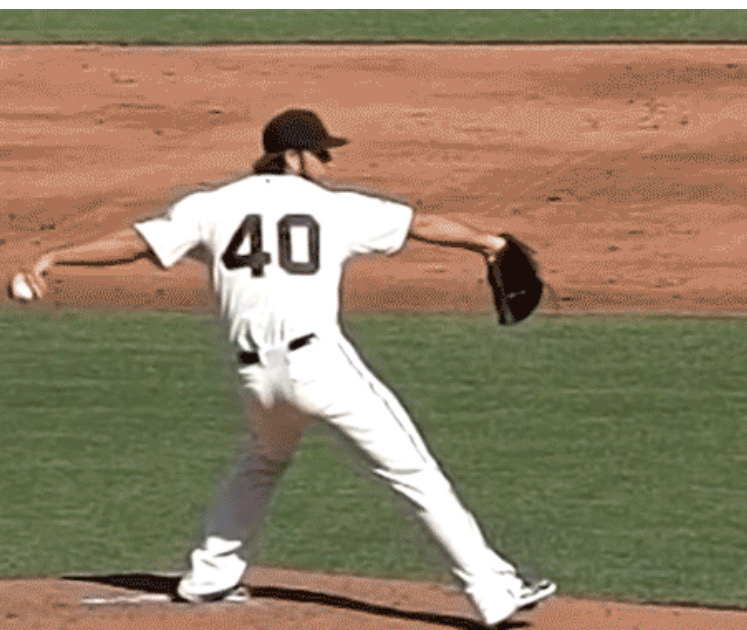
![]() By Dr. John R. Mishock, PT, DPT, DC
By Dr. John R. Mishock, PT, DPT, DC
The baseball pitcher is the most vital position in baseball. The success of the baseball pitcher not only requires high-level ability but also requires durability and prevention of injury. Science has also shown that in elite baseball pitchers, 85% of throwing velocity comes from leg drive (push-off and stride length), hip and torso rotation (shoulder-hip separation), and shoulder cocking (scapular loading and shoulder lay back). (Roach et al., 2014) Therefore, in elite baseball pitchers, the arm only accounts for 15% of the throwing velocity. However, if a player has poor pitching mechanics, the arm may be overutilized, leading to poor pitch performance and injury potential. In this article, I will discuss short-arm versus long-arm action during pitching. Coaches, trainers, and parents can find a detailed description of pitching mechanics in my book “The Rubber Arm: Using Science to Increase Pitch Control, Improve Velocity, and Prevent Elbow and Shoulder Injury,” found on Amazon.
During pitching, the short or long arm action occurs just after the hand leaves the baseball glove, before the front stride foot contacts the ground, and before the late cocking phase of the pitch mechanics. Short arm action is less than 120 degrees of elbow extension (0 degrees is the arm fully extended or straight) at front stride foot contact.
As the hand leaves the glove during pitching, the arm extends back behind the body (horizontal abduction). The shoulder blade (scapular loading) retracts, stretching the front shoulder and chest muscles (latissimus dorsi, pectoralis major, and minor muscles). The “scapular loading” creates potential or elastic energy, which will be released and added to muscle contraction forces during throwing (Stodden et al., 2005). The more stretch or horizontal abduction at the front foot strike, the greater the potential for ball velocity. Following “scapular loading,” the body will move into shoulder external rotation, scapular posterior tilt, and thoracic extension, known as “lay back.” “Lay back” places a stretch on the shoulder’s internal rotators (subscapularis and latissimus dorsi muscles), creating stored elastic or potential energy representing another opportunity for ball velocity. In order to optimize efficiency and velocity, both the “scapular loading” and “lay back” are essential. The short arm action creates a mechanical advantage by keeping the arm closer to the body, maintaining “scapular loading and lay back,” thus allowing increased torque and arm speed.
If the elbow is too straight (extension angle of less than 120 degrees) at stride foot contact, it can reduce the elastic or potential energy from “scapular loading’ and “lay back .” This inefficiency causes an energy leak (reduced power), thus reducing arm speed and eventual ball velocity. The delay in the arm mechanics creates an inverted V or a W position when viewed from the side at the front foot strike. Beyond the potential energy leak and lost ball velocity, the inverted “W” causes the arm to “drag” through the throwing zone leading to increased stress on the elbow and shoulder. This biomechanical strain can lead to ligament and muscle injury of the shoulder and elbow. (Campbell et al. April 2010, Wiemi et al. April 22, 2015)
When teaching pitching, there are a few coaching points that can optimize this phase of the pitch mechanics. First, as the ball is removed from the glove (glove-hand separation), keep the hand on top of the ball. Secondly, at front stride contact, keep the ball above the height of the elbow with a bend of less than 120 degrees. This positioning forms a “V or W” position when viewed from the side. This arm position helps to protect the elbow and shoulder while optimizing the elastic or potential energy from “scapular loading and shoulder lay back.”
As a coach or parent, it is also important to note these pitch mechanics and potential changes during competitions. As the pitcher fatigues during throwing, it is common to see the elbow dropping and the development of long arm action throwing, leading to poor pitch control. This fatigue leads to a lack of “scapular loading,” which puts excessive stress on the elbow (wrist flexor-pronator strain and ulnar collateral ligament) and shoulder (glenoid labrum, rotator cuff, and biceps tendon). Remember that fatigue during throwing is the number one risk factor for injury, representing a thirty-five times increased risk of shoulder or elbow injury.
The way each pitcher throws a ball is unique to the individual with many different arm slots (natural biomechanical motions of the arm during throwing), such as overhand, ¾, or sidearm. The arm slot is unique to the player’s anatomy and physiology and should not be changed. However, creating the “V or W formation” at foot contact is critical to optimizing ball velocity and, more importantly, preventing injury. Keep in mind that durability as an athlete is as important as ability.
Mishock Physical Therapy can HELP!
Reduce pain and increase function
Call to schedule your appointment or a FREE Phone Consultation 610-327-2600.
Appointments available 7:00am to 8:00pm, ALL locations, most days
Saturday appointments available
Email your questions to mishockpt@comcast.net
Visit our website to request an appointment, meet our physical therapy staff, and learn about our treatment philosophy.
John R. Mishock, PT, DPT, DC, is one of only a few clinicians with doctorate level degrees in both physical therapy and chiropractic in the state of Pennsylvania.
He has also authored two books; “Fundamental Training Principles: Essential Knowledge for Building the Elite Athlete”, “The Rubber Arm; Using Science to Increase Pitch Control, Improve Velocity, and Prevent Elbow and Shoulder Injury” both can be bought on Amazon.
